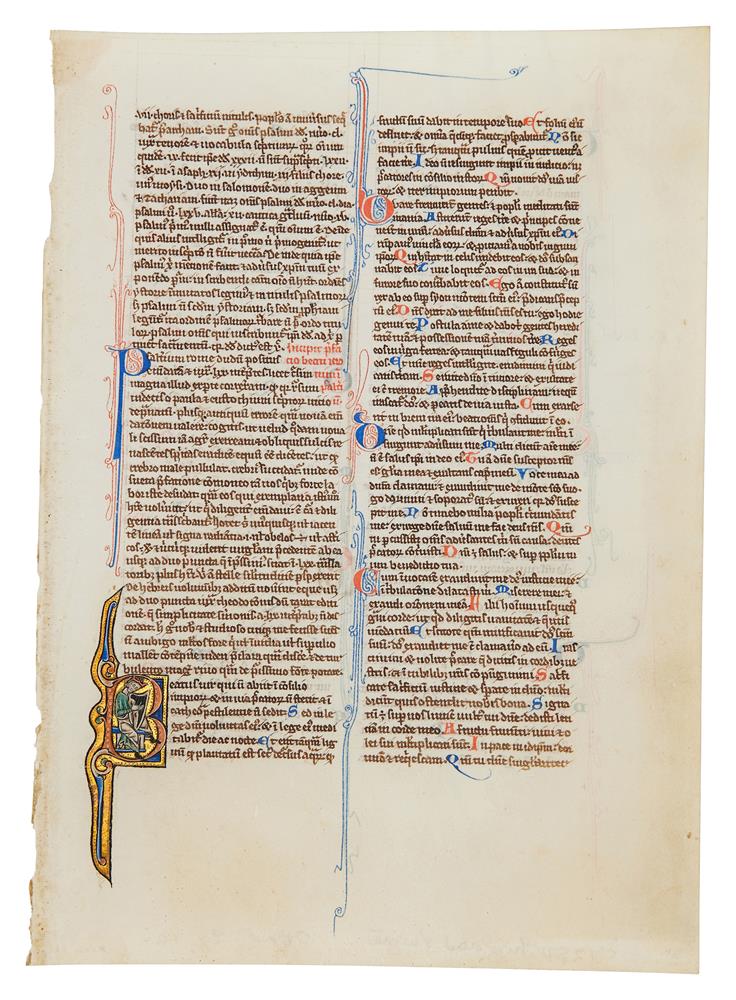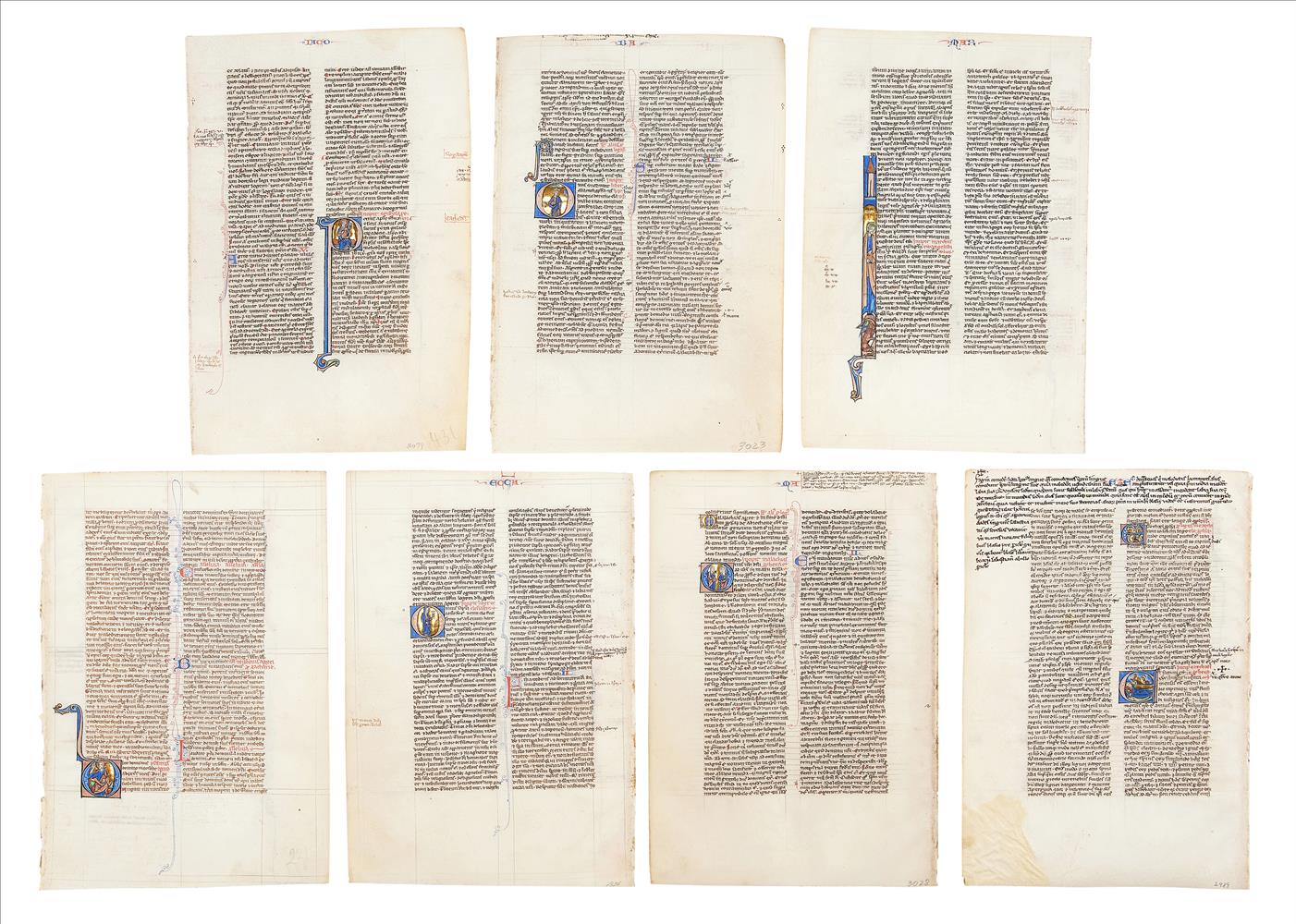BIBLE, in Latin, ILLUMINATED MANUSCRIPT ON VELLUM
BIBLE, in Latin, ILLUMINATED MANUSCRIPT ON VELLUM [Bologna, c.1310-1315] 305 x 220mm. 541 leaves preceded and followed by marbled paper bifolia: 1 9 (of 10, i a cancelled blank), 2-52 1 0, 53-54 6, COMPLETE, catchwords on most final versos except the added first and final two gatherings and gathering 24 with the end of Psalms, the catchwords within decorative framings, including a fish (9) and human faces (21), various series of signatures, usually in ink in the lower right-hand corner of leaves; two columns of 48 lines in brown ink in a round gothic bookhand between four verticals and 49 horizontals ruled in plummet, justification: approx. 205 x 68-13-70mm (the Interpretations of Hebrew names in three columns), prickings survive frequently in the upper and lower margins, rubrics in red, capital letters stroked in red, numerous guides to the rubricator survive in the margins, OPENING PAGE WITH LARGE HISTORIATED INITIAL AND A THREE-SIDED ACANTHUS BORDER INCORPORATING DROLLERIES AND TWO HISTORIATED ROUNDELS, GENESIS PAGE WITH A MINIATURE, LARGE CREATION INITIAL AND A MINIATURE IN THE LOWER BORDER, a further SIXTY-SEVEN LARGE HISTORIATED INITIALS WITH FOLIATE EXTENSIONS INTO THE MARGINS, chapters and most prologues with three-line initials alternately red and blue with penwork of the other colour, chapter numbers and running titles written in letters alternately red and blue (staining to gutters of first two gatherings from binding paste? affecting the borders on f.10 and 13, slight darkening to margins, occasional inconsequential spotting, small hole in f. 286, top corner of f. 244 torn off). Central or eastern European 16th-century panelled brown leather over wooden boards, borders and central lozenge tooled in blind with a foliate roll between ruled fillets, the upper cover with Christ Crucified and the lower cover with the Virgin and Child on a Crescent Moon at centre, two catches, spine overlaid with ?18th-century brown reversed calf, itself over an older repair; remains of a 19th-century orange leather title-piece lettered in gilt "VET. ET [...]" (lacking clasps and straps, head and tail of leather at spine missing, extremities rubbed). In a fitted cloth box. A HANDSOME AND EXTENSIVELY ILLUMINATED FOLIO BIBLE SIGNED BY THE SCRIBE, MASTER CABRINUS OF CREMONA PROVENANCE: 1. Signed by the scribe Cabrinus of Cremona at the end of the main biblical text and also at the end of the Interpretations of Hebrew names: 'Gratia domini nostri Ihesu Christi eiusdemque matris virginis Marie, magister Cabrinus de Cremona hunc librum scripsit. Deo gratias' (f. 495r) and 'Expliciunt interpretationes bibliotece. Deo gratias Cabrinus scripsit' (f. 534). From his title 'magister' Cabrinus had presumably studied at the university in Bologna or Paris; the fact that he described himself as 'of Cremona' suggests either that he was working somewhere else (e.g. Bologna), or else if he wrote the book in Cremona, he knew that the book was for a patron somewhere else. The style of illumination suggests that the book was decorated in Bologna (about 80 miles south-east of Cremona). The large size of the book and grand scale of script and decoration may indicate an institutional use, and the three depictions of Carmelites (ff. 10r, 13r, 241v) suggest that it could have been made for San Martino, the Carmelite house in Bologna. 2. The added texts at the front and back suggest that the volume was still in institutional ownership in the fifteenth century. The style of the script and decoration indicates that the manuscript had by then moved north of the Alps. 3. In the 19th century the volume seems to have been owned by a Russian resident in France who wrote 'Ex libris F[ratris?] Alex Balaschewitch [/Balaschewitch Balasetiewitch]' in the gutter of f.538. There is a 19th-century red wax customs seal with three fleurs-de-lis under a closed crown (somewhat damaged) on the front endleaf. 4. In an English private collection since the early 20th century. CONTE
BIBLE, in Latin, ILLUMINATED MANUSCRIPT ON VELLUM
BIBLE, in Latin, ILLUMINATED MANUSCRIPT ON VELLUM [Bologna, c.1310-1315] 305 x 220mm. 541 leaves preceded and followed by marbled paper bifolia: 1 9 (of 10, i a cancelled blank), 2-52 1 0, 53-54 6, COMPLETE, catchwords on most final versos except the added first and final two gatherings and gathering 24 with the end of Psalms, the catchwords within decorative framings, including a fish (9) and human faces (21), various series of signatures, usually in ink in the lower right-hand corner of leaves; two columns of 48 lines in brown ink in a round gothic bookhand between four verticals and 49 horizontals ruled in plummet, justification: approx. 205 x 68-13-70mm (the Interpretations of Hebrew names in three columns), prickings survive frequently in the upper and lower margins, rubrics in red, capital letters stroked in red, numerous guides to the rubricator survive in the margins, OPENING PAGE WITH LARGE HISTORIATED INITIAL AND A THREE-SIDED ACANTHUS BORDER INCORPORATING DROLLERIES AND TWO HISTORIATED ROUNDELS, GENESIS PAGE WITH A MINIATURE, LARGE CREATION INITIAL AND A MINIATURE IN THE LOWER BORDER, a further SIXTY-SEVEN LARGE HISTORIATED INITIALS WITH FOLIATE EXTENSIONS INTO THE MARGINS, chapters and most prologues with three-line initials alternately red and blue with penwork of the other colour, chapter numbers and running titles written in letters alternately red and blue (staining to gutters of first two gatherings from binding paste? affecting the borders on f.10 and 13, slight darkening to margins, occasional inconsequential spotting, small hole in f. 286, top corner of f. 244 torn off). Central or eastern European 16th-century panelled brown leather over wooden boards, borders and central lozenge tooled in blind with a foliate roll between ruled fillets, the upper cover with Christ Crucified and the lower cover with the Virgin and Child on a Crescent Moon at centre, two catches, spine overlaid with ?18th-century brown reversed calf, itself over an older repair; remains of a 19th-century orange leather title-piece lettered in gilt "VET. ET [...]" (lacking clasps and straps, head and tail of leather at spine missing, extremities rubbed). In a fitted cloth box. A HANDSOME AND EXTENSIVELY ILLUMINATED FOLIO BIBLE SIGNED BY THE SCRIBE, MASTER CABRINUS OF CREMONA PROVENANCE: 1. Signed by the scribe Cabrinus of Cremona at the end of the main biblical text and also at the end of the Interpretations of Hebrew names: 'Gratia domini nostri Ihesu Christi eiusdemque matris virginis Marie, magister Cabrinus de Cremona hunc librum scripsit. Deo gratias' (f. 495r) and 'Expliciunt interpretationes bibliotece. Deo gratias Cabrinus scripsit' (f. 534). From his title 'magister' Cabrinus had presumably studied at the university in Bologna or Paris; the fact that he described himself as 'of Cremona' suggests either that he was working somewhere else (e.g. Bologna), or else if he wrote the book in Cremona, he knew that the book was for a patron somewhere else. The style of illumination suggests that the book was decorated in Bologna (about 80 miles south-east of Cremona). The large size of the book and grand scale of script and decoration may indicate an institutional use, and the three depictions of Carmelites (ff. 10r, 13r, 241v) suggest that it could have been made for San Martino, the Carmelite house in Bologna. 2. The added texts at the front and back suggest that the volume was still in institutional ownership in the fifteenth century. The style of the script and decoration indicates that the manuscript had by then moved north of the Alps. 3. In the 19th century the volume seems to have been owned by a Russian resident in France who wrote 'Ex libris F[ratris?] Alex Balaschewitch [/Balaschewitch Balasetiewitch]' in the gutter of f.538. There is a 19th-century red wax customs seal with three fleurs-de-lis under a closed crown (somewhat damaged) on the front endleaf. 4. In an English private collection since the early 20th century. CONTE

.jpg)
.jpg)
.jpg?w=400)
.jpg)
.jpg?w=400)

.jpg?w=400)



Testen Sie LotSearch und seine Premium-Features 7 Tage - ohne Kosten!
Lassen Sie sich automatisch über neue Objekte in kommenden Auktionen benachrichtigen.
Suchauftrag anlegen